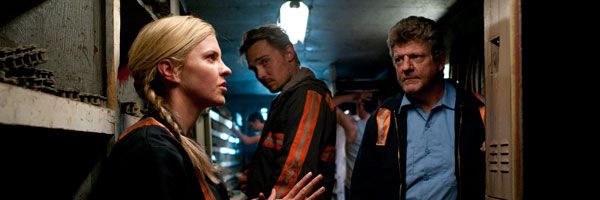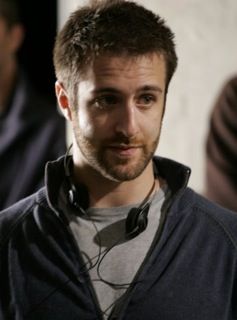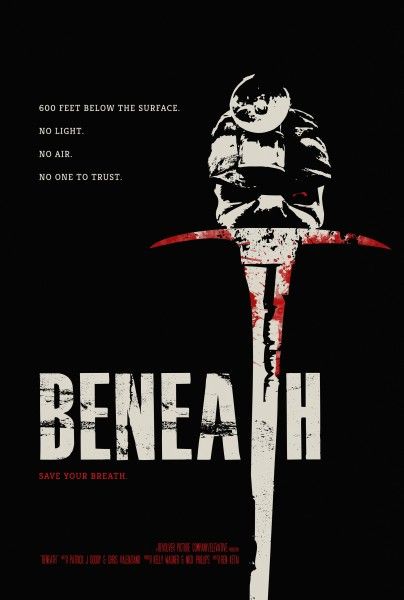Coming to VOD this week and arriving in theaters July 25th is Beneath, a claustrophobic thriller centered on a group of coal miners as they struggle for survival following a catastrophic cave-in. Things go from really bad to even worse when the survivors start hearing mysterious noises and suffering horrifying visions. With bodies piling up and the cave's air supply growing more toxic by the minute they must figure out who or what is after them. Beneath stars Jeff Fahey, Joey Kern, Kelly Noonan, Brent Briscoe and Eric Etebari.
Earlier this week I had the opportunity to jump on the phone for a one on one interview with director Ben Ketai. He talked about what he loved about the script, the challenges of shooting in such a confined space, creating a sense of claustrophobia, how the project changed along the way, and more. Check out what he had to say after the jump.
Collider: Tell me a little bit about how Beneath came together for you.
BEN KETAI: It came together surprisingly fast and in a way that feature films almost never do. It was this really wonderful script that Patrick [Doody] and Chris [Valenziano] had written and was getting ready to get produced by Revolver with Nick Phillips and Kelly Wagner, and they had everything ready to go with it but they still needed a director. I jumped on and I was sort of the last piece of the puzzle. They were eager to get it into production. They had the money and they had already decided they wanted to shoot in L.A.. Literally from the time I first met with them about the project to the time we were shooting it was like six weeks. So it came together very quickly, but after going through the experience waiting for features to go or eventually not go this was a very refreshing experience.
So had they already started casting or did the actors come on in those six weeks?
KETAI: They came on in those six. Kelly's background is in casting so she was able to pull together some resources and get the ball rolling really fast. It was a pretty quick and rigorous casting process, but the wonderful thing about it was we didn't have a studio to answer to. So it was, again, another very refreshing process where the producers were on board obviously with the ideas and making the best movie possible and casting the best people possible. It was really the most traditional kind of casting process I've ever been through where we literally just had people come in and audition, then we had call backs, then we mixed and matched and ended up putting together the best cast we thought we could for telling the story. As opposed to generally you get through that process and you end up having to just go with whoever has the most foreign value or whatever it is.
Whatever you did worked out great, because the cast was awesome.
KETAI: Thank you.
Yeah, and one of the best things about this movie is the characters. A lot of times in low budget horror films you don't have the time or the space to explore characters, but I really liked every one in the film.
KETAI: Yeah, that was definitely one of the things, other than just the conceit itself, the thing in this movie, this script, was that it had such rich and vibrant characters that just kind of jumped off the page. It was something that was just a real strength of the writing. The most important thing for me as a director above all- above genre, above the scares, above the concept, are the characters. Those are the people that I want the audience to latch onto. Obviously that's how we experience the movie. I worked closely with the writers and the cast. We kind of all came together once those pieces were in place and it was just sort of a constantly evolving thing where the actors were able to have some agency over who they were on the screen, and they got to have a little bit of input into it the next draft of the script and so on and so forth. I think allowing them that freedom and allowing them to create each character individually and kind of bring it all together made for great chemistry and a real sense of believability.
Definitely. It’s interesting, you talk about how the script evolved. A lot of movies change along the way. How different is this final product that I just watched from what you started with?
KETAI: There's a couple major things- or I wouldn’t say major, but a couple more general things that permeate the entire movie, much of which had to do with the tone of the horror genre itself. When I first came aboard the project it was more of a supernatural thriller. Whether it's a horror movie or just drama if it's set in a coal mine, it's going to be suspenseful. For me at least, I read the script and I was claustrophobic just reading the script. We've seen people trapped in tight places before with scary monsters and things like that, so the biggest thing that I brought to it creatively and that I pushed to have evolve, and everybody was on board with it too which was wonderful, was making a little more psychological, making it a little more ambiguous as to what the threat was early on so that you felt like you were actually kind of unraveling psychologically with these people as opposed to being just a very cut and dry supernatural force. So that was really the only major change that we made, because the characters were pretty much there. Like I said, when I read the script I was immediately drawn to the characters and the structure of the movie. I think it was just really navigating how much we show and tell.
Interesting, so it started out with a much more upfront threat?
KETAI: Yeah, it was more about peeling back the mystery of The Nineteen, which is mentioned in the movie, and just sort of planting that seed in your mind and obviously in the character's minds. The original script had a lot more to do with the history and the back story of the nineteen and obviously that's much more supernatural and directly tied to these sort of ghostly coal miners. But I wanted to try and make it more ambiguous. If you've heard a ghost story before you’re going to project that onto your own situation. Like if you buy a house and somebody tells you that an old lady died in that house you might just see an old lady out of the corner of your eye one night because it's already in the back of your mind. It doesn't necessarily mean it's happening. So really it was just a matter of getting rid of the things that were so firmly entrenched in the idea that these are ghosts, this is supernatural. It was really more a process of subtraction than addition.
You mentioned that the idea of claustrophobia is inherent to caves and mining, but you did a great job of bringing that part out. Can you talk about how you approached not only the scare set pieces, but also the claustrophobic set pieces?
KETAI: Absolutely, that was the most fun part of the movie and also the most challenging just because even though we amazingly filmed the entire coal mine on a soundstage, credit to Michael Barton our incredible production designer for making that feel real, we still had to fit the camera into the fake coal mine and have the actors and the crew cramp in there. So it was a claustrophobic experience just making the movie. For myself and for Mike, his goal, and what we talked about early on, was to start obviously in a dark tight space, but gradually as the story evolves the space itself gets smaller and smaller. So we kind of plotted it out where early in the movie when they're in this tunnel, there will be this much head room and this much width. Likewise for my cinematographer Tim Burton, we talked about obviously lens choices and how we would make it either feel like a bigger, more open space or more claustrophobic and right up in the characters face like there's nowhere else to go. We just kind of let that evolution track along with the psychological downward spiral and also just the actual geography of the coal mine. I think when it's all cut together it had the intended affect.
[Laughs] I would definitely would agree with that. You know, cameras are huge, how difficult was it getting these shots in those spaces or was there a lot of trickery going on?
KETAI: Yeah, it was not easy, especially because we wanted to use the Alexa, which is a bigger camera than many, but it photographs so well in the dark. It has so much detail in the black that we absolutely had to go with it. We kind of painted ourselves into a corner though with how much navigation room we had within those tunnels. We were on such a tight budget we didn’t even really have the budget to cross section the tunnels and pull them apart to be able to shoot like that. We really just had to jam the camera in there. I think a lot of the credit goes to our camera operators who were just so athletic and able to crouch into these tight corners and spaces with a camera on their shoulder. The one thing we had going for us was that I like to shoot almost everything handheld, so we were able to work with just the camera and not have to work about tripods or dolly tracks or anything like that. So that was a big bonus for us. There were other sequences like the scene where she was actually stuck in that crack, that was probably the biggest challenge for us as far as the camera. We had to build the system, there was like a tiny pole on the top that ran along the top of that scene and we actually had a bungee cord that was lowered down with the camera to basically be right in front of the actress and then we had a camera operator kind of shimmy in there with her and guide the camera, but there definitely was not enough room for an operator to be in there with a camera on his shoulder. So that was an interesting contraption [laughs].
That's cool, you get to be inventive.
KETAI: Exactly, that the fun part about it, just solving the problems.
I would like to extend an honest and heartfelt thank you for making a ninety minute movie, that never seems to happen anymore. What was your assembly cut and did you cut a lot? What was your editing process like?
KETAI: We actually didn’t struggle that much to get it down. Because of our limited budget and our limited shooting schedule we kind of went into with the script whittled down to only essentially what we needed. I think there may be one scene actually that ended up on the cutting room floor. It was a brief scene before they go into the mine. It was a good little piece of character, but we just felt like we got to get into that faster. I'm a huge fan of ninety minute movies, especially genre films, I don’t think it should take more than ninety minutes to tell any story, and I feel like if it does take longer than ninety minutes there might be something wrong with it [laughs]. But that's just me. I grew up with the short attention span generation. I had a wonderful editor, Toby Wilkins, who knows how to trim the fat before you even sit down to watch it. He knows exactly what's needed to tell a story. It was really actually a breeze sitting down and watching the assembly when we first started the editorial process. It was not hard to make it a ninety minute movie.
Despite the opening title card that says "Based on true events", there are obviously some liberties taken, but did you do any research in to real life mining collapses or talk to any of the survivors of that?
KETAI: Well it says inspired by true events, it's not actually based on a true story or anything. The writers were inspired by the frequency with which we were seeing coal mining collapses. We never actually got to interview anyone who was trapped in a coal mine itself, but the writers had done extensive research for well over a year through the development of the script and talked with various coal miners around the country. We actually had one guy fly out to speak with the cast and crew about the experience of working in the mine and what it does to you psychologically even without collapse. That was really fascinating. I felt really lucky to be a part of a movie like this because I was learning something. That's what's cool about being a filmmaker is you learn thins you would never otherwise learn.



